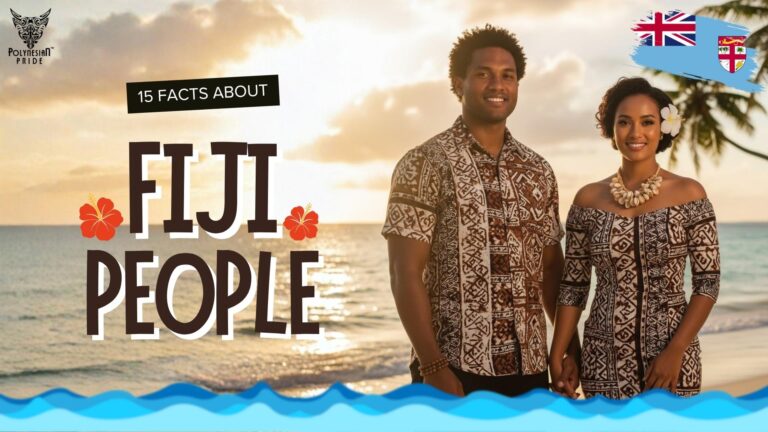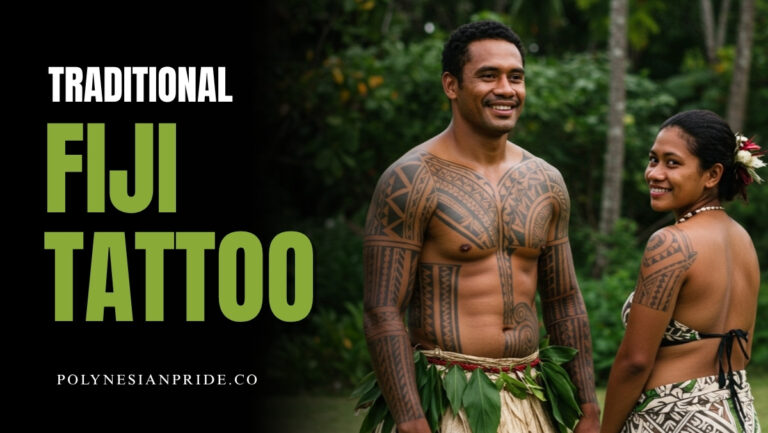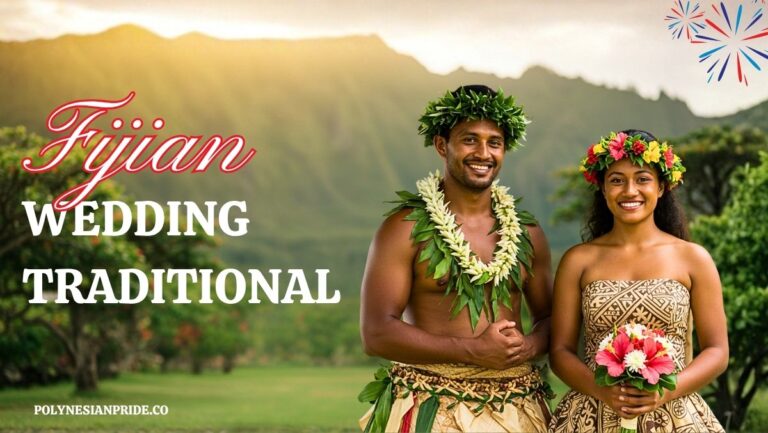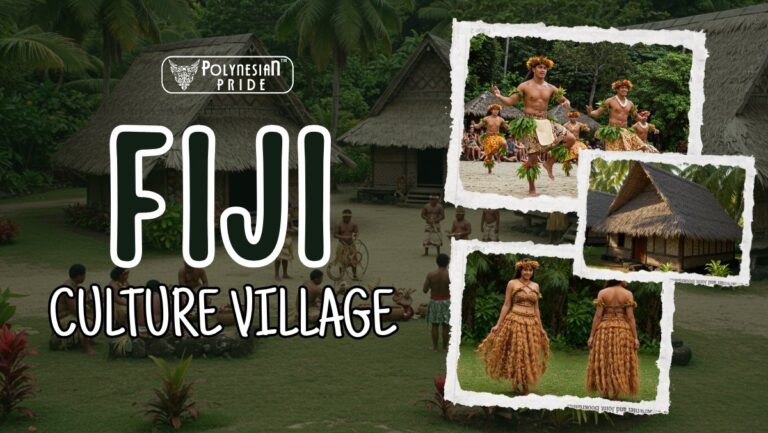Fiji Traditional Songs – The Soulful Sound of the Islands
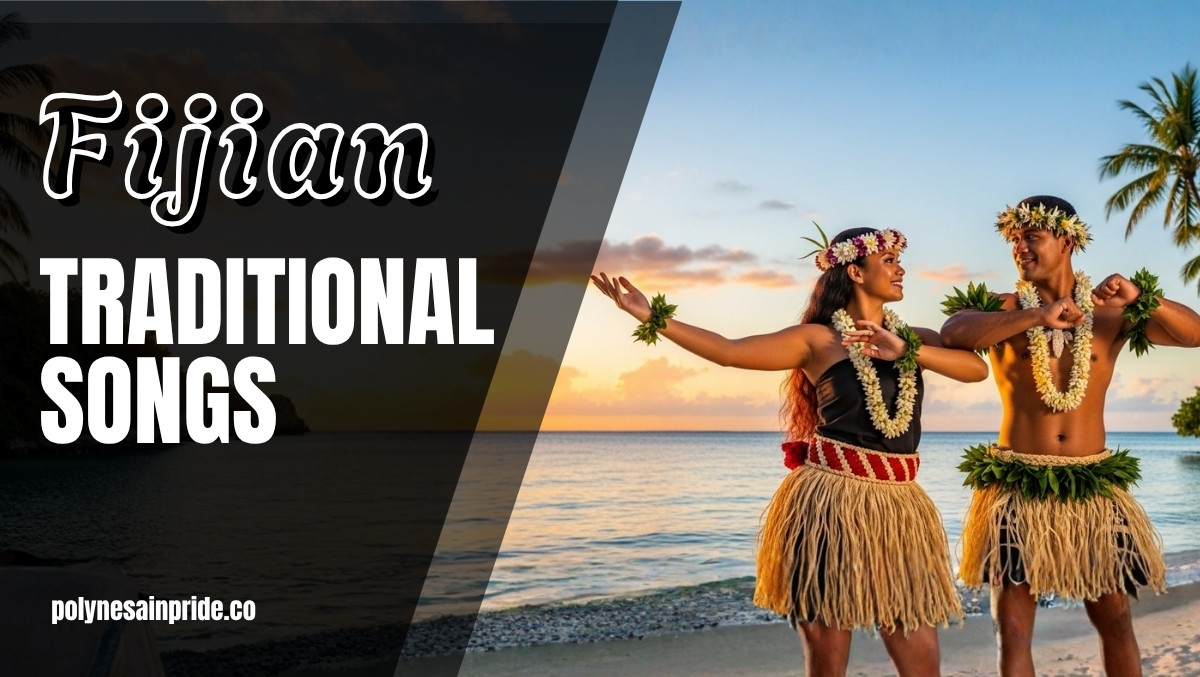
The Voice of Fiji’s Heritage
The sound of Fiji traditional songs is the heartbeat of island life — a living expression of faith, unity, and ancestry. From the rhythmic Lali Drum to the graceful Meke performances and soothing Fijian choirs, music in Fiji tells stories older than memory itself. Rooted in Pacific island music and enriched by indigenous Fijian chants, these melodies capture both celebration and spirituality.
This article explores the origins, instruments, ceremonial roles, and deep cultural meaning behind Fiji’s musical traditions — a legacy that continues to unite the islands today.
The Origins and Role of Traditional Music in Fiji
Music has always been at the heart of Fijian life — a bridge between the spiritual and the everyday. The traditional music of Fiji reflects the islands’ communal spirit, its connection to nature, and the enduring rhythm of Pacific heritage.
Origins of Fijian Music and Its Ancestral Roots
The origins of Fijian traditional songs date back thousands of years. Early islanders believed music was a divine gift connecting people, land, and sea.
Early rhythms came from nature — the sound of waves, birds, and wind. Over time, voyagers from nearby Pacific islands brought new melodies and chants, blending with indigenous Fijian chants to create a unique musical identity.
These songs became more than entertainment. They expressed spirituality, nature, and community, forming the foundation of Fijian folk music heard today.
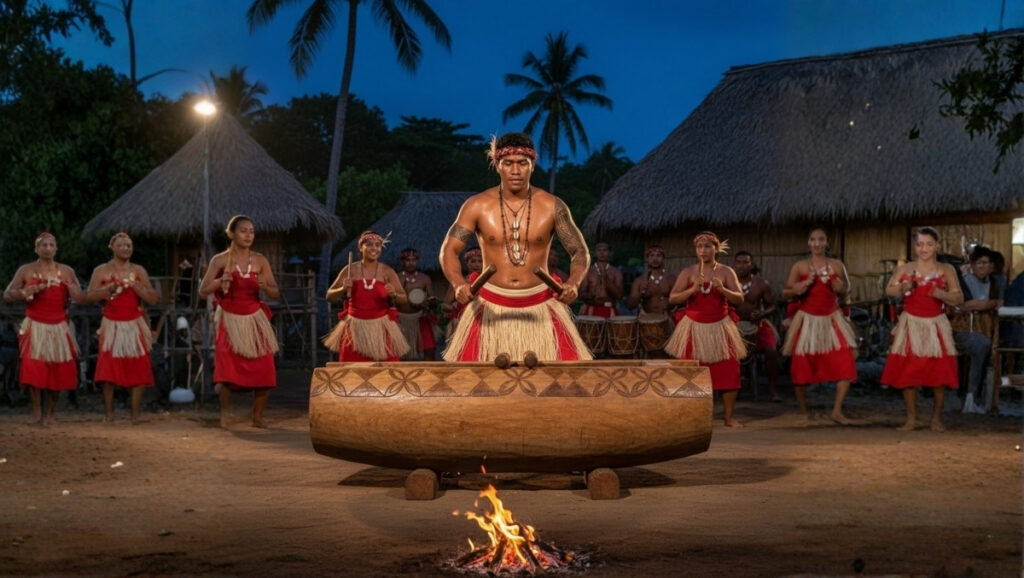
Music as Storytelling and Oral Heritage
In ancient villages, songs carried stories — legends of gods, heroes, and the natural world. Through indigenous Fijian chants and poetic rhythms, communities preserved history long before written language.
- Fijian lullabies and storytelling songs taught values of respect, courage, and unity.
- Lyrics often reflected daily life, from planting crops to navigating the seas.
- The repetition of the melodies made them easy to pass down through generations.
This tradition turned every song into a form of oral heritage, keeping Fiji’s myths and wisdom alive through music.
Village Singing Traditions and Ceremonial Use
Within every Fijian village, music accompanies every stage of life — from birth to marriage, from mourning to celebration. Singing is a communal act, guided by rhythm and harmony rather than written notes.
- Chiefly, ceremonial music is performed during village gatherings, honoring leaders and ancestral spirits.
- Fijian festival songs celebrate the harvest, love, and unity.
- Certain Fijian ceremonial music pieces are sung only on sacred occasions, maintaining their spiritual purity.
In these gatherings, music becomes more than sound — it is a shared breath of identity, echoing through generations as the living soul of Fiji.
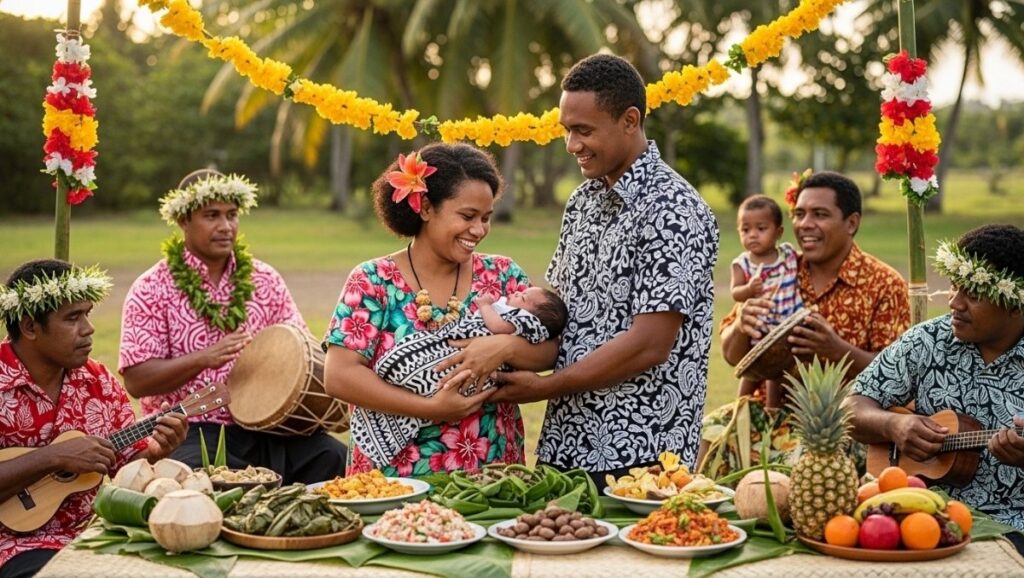
The Meke – Fiji’s Most Iconic Song and Dance Tradition
Among all forms of Fijian cultural performances, the Meke stands as the most powerful — a mesmerizing blend of song, dance, and storytelling that embodies strength, grace, and devotion. Rooted in ancestral chants and indigenous Fijian rituals, the Meke began as a sacred offering to gods and chiefs during ceremonial events.
Each performance tells a story — of love, war, or the forces of nature — passed down through generations as both entertainment and worship.
1. The Structure of the Meke Performance
Every Meke unfolds like a living story performed by two groups:
- Vakatara — the chanters who lead with rhythmic chants, narrating the tale and guiding the dancers’ pace and emotion.
- Matana — the dancers who translate the chants into movement, expressing the story through gestures, posture, and rhythm.
Their harmony of voice and movement reflects Fiji’s belief in unity between people and the spiritual world.
Each version of the Meke has its purpose: some praise chiefs, others celebrate nature, or tell stories of love and war. The rhythm mirrors the ocean’s tides — constant, flowing, and deeply connected to the heartbeat of the islands.
2. Choreography and Movement
Every Meke is choreographed to tell a story — of war, love, nature, or faith. Dancers use their bodies as instruments of expression, translating myth and memory into precise gestures.
- Male performers embody strength and valor through vigorous, grounded movements. Their foot-stomping and weapon gestures often depict warriors preparing for battle or defending the village.
- Female performers move with elegance and restraint, their hand and hip motions symbolizing harmony, fertility, and spiritual grace.
Each movement carries cultural weight — lifting the hands to the sky invokes blessings from the gods, while sweeping motions toward the earth pay respect to the ancestors. The choreography is both ritual and art, guided by the belief that dance can communicate with the unseen world.
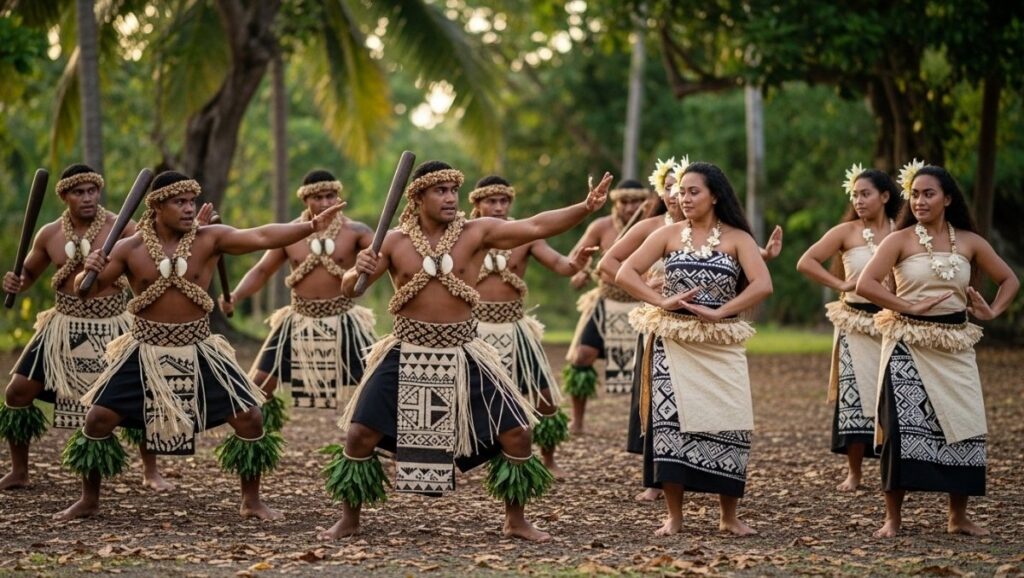
3. Rhythm and Vocal Performance
Unlike Western music, the Meke is guided not by melody but by rhythm and tone. The steady pulse of Lali Drum rhythms and Derua bamboo percussion provides the foundation, while voices form layered harmonies that rise and fall like ocean waves. The result is a hypnotic interplay of sound and movement — deeply emotional, yet disciplined.
- The chorus of singers, often positioned behind or around the dancers, performs indigenous Fijian chants with dynamic intensity. Their delivery alternates between loud, sharp exclamations and soft, haunting echoes.
- The songs are sung in Fijian polyphonic harmonies, a hallmark of island choral tradition, where multiple voice parts intertwine to create depth and resonance.
- Lyrics recount ancestral battles, the deeds of chiefs, or the blessings of the gods, ensuring that Fijian village singing traditions remain an active vessel of memory.
Rather than aiming for entertainment, each vocal phrase is an invocation — music as a medium of faith and continuity.
4. Attire, Setting, and Symbolism
Visual presentation is an essential part of the Meke’s power. Performers wear masi (tapa cloth) garments hand-painted with traditional motifs representing lineage, protection, and unity. Natural accessories — garlands of leaves, shell necklaces, or woven belts — add texture and rhythm, accentuating movement under the tropical light.
The performance space, usually an open village ground (rara), becomes a sacred stage. It is not merely a backdrop but an extension of the story:
- The circle formed by dancers symbolizes community and continuity.
- The direction of movement often follows the sun’s path, aligning human rhythm with cosmic order.
- Offerings of kava or flowers may be placed at the center, linking the dance to chiefly ceremonial music traditions.
Every visual and spatial element reinforces the sacred connection between people, nature, and the divine — the essence of Fijian ceremonial music.
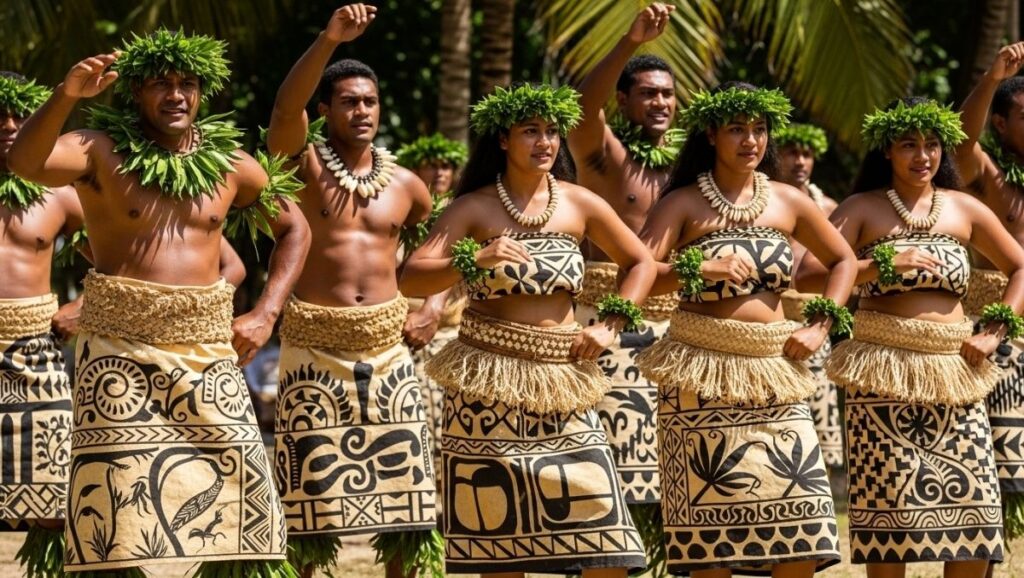
Traditional Instruments – The Sound of the Islands
The heartbeat of Fijian traditional music comes alive through its instruments — hand-carved, nature-made, and spiritually inspired. Each one carries its own purpose and story: to gather the community, praise the gods, or guide the rhythm of the Meke.
The Lali Drum – The Pulse of Fijian Life
The Lali Drum is perhaps the most iconic instrument in Fiji — carved from hollowed hardwood and struck with sticks to produce a deep, resonant tone. Historically, it was more than a musical instrument; it was a signal.
- In daily life, it marked time, called villagers to gather, or announced births, deaths, and ceremonies.
- In spiritual practice, it served as the voice of the gods, summoning people for rituals and festivals.
- In performance, Lali’s rhythm anchors songs and dances like the Meke, giving structure to chants and movements.
Each beat carries both urgency and reverence — a rhythmic reminder that music in Fiji connects the physical and spiritual worlds.
Derua Bamboo Percussion – Nature’s Rhythm Maker
The Derua is a traditional bamboo percussion instrument made from hollow tubes of varying lengths. When struck together or against the ground, they create sharp, lively tones that weave through songs and chants.
- Craftsmanship: Each Derua is carefully cut, dried, and tuned to produce different pitches. Its lightweight build allows performers to move while playing, integrating rhythm into dance.
- Function: The Derua complements the Lali by filling spaces between beats, creating intricate cross-rhythms that mirror the syncopation of waves and wind.
- Cultural significance: It symbolizes harmony with nature — transforming bamboo, a common island plant, into a sacred sound that guides both ceremony and celebration.
Its simplicity belies its emotional power; the Derua brings texture and brightness to Fijian ceremonial music and village celebrations alike.
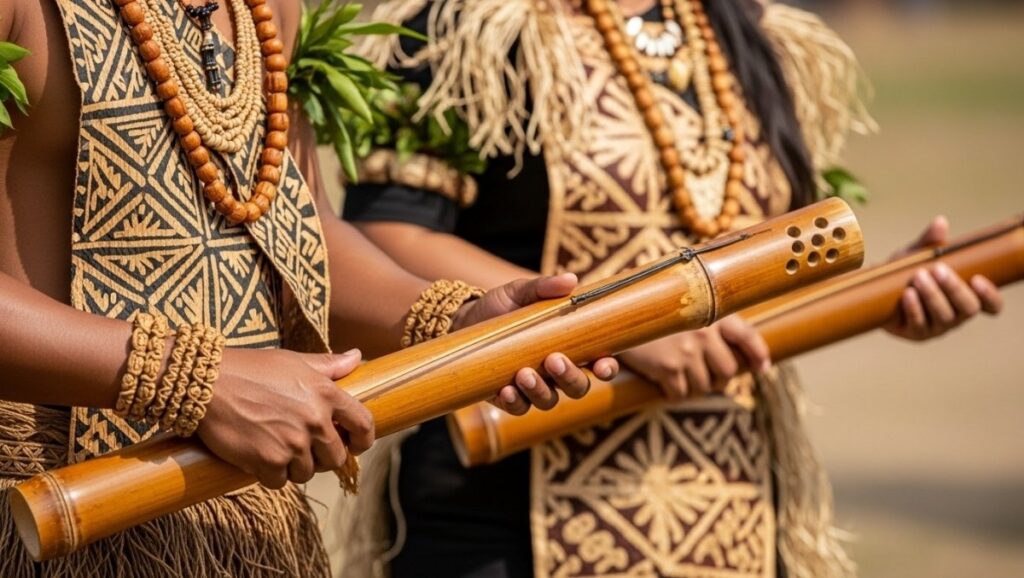
Conch Shells and Other Natural Sound Makers
Before the Lali, sound traveled across the islands through conch shells (davui). Blown like trumpets, they announced important events or the approach of visiting chiefs. Their deep, echoing tone was believed to carry messages to the gods and ancestors over land and sea.
Alongside it, other instruments added texture and ritual color:
- Rattles and seed pods accentuated dancers’ movements.
- Wooden slit drums echoed the beat of communal gatherings.
- Shell and bone instruments provided percussive accents during storytelling of Fiji traditional songs and ancestral chants.
Each of these sound-makers reflects the islanders’ deep respect for nature — every leaf, shell, and branch could become part of a melody that spoke to both gods and people.
Comparison of Materials and Tones of Traditional Fijian Instruments
To better understand the diversity and function of these instruments, the table below compares their materials, tones, and cultural significance in Fijian music.
| Instrument | Material & Construction | Sound Quality / Tone | Cultural Function | Modern Use |
| Lali Drum | Carved from hardwood, played with wooden sticks | Produces a deep, resonant tone similar to a log drum or slit drum, with strong projection and low frequencies | Used to announce gatherings, rituals, and guide Meke rhythms | Still central in villages, churches, and cultural ceremonies |
| Derua Bamboo Percussion | Hollow bamboo tubes, cut and tuned to length | Creates a sharp, wooden clack resembling bamboo clappers or angklung, offering a clear rhythmic texture | Adds pace and texture to dances, symbolizing harmony with nature | Common in school programs and national festivals |
| Conch Shell (Davui) | Natural sea shell, blown like a trumpet | Produces a low, resonant drone comparable to a French horn, with a sustained, echoing tone | Announced chiefs or sacred gatherings, linked to ancestral spirits | Played ceremonially and in resort welcomes |
| Rattles & Seed Pods (Civa, Buli) | Dried seeds, shells, or woven fibers | Generates a light rattling sound similar to maracas or ankle shakers, complementing dance movements | Accentuates dancers’ movements during Meke, often tied to wrists or ankles | Used in dance troupes and cultural education |
| Wooden Slit Drum | Hand-carved from solid logs, slit for resonance | Delivers a booming hollow tone, like a bass log drum or African slit drum, used for deep rhythmic beats | Served for timekeeping and communication in rituals | Recreated by artisans in heritage preservation projects |
Today, Fiji’s traditional instruments remain vital in island life. Local artisans and musicians still handcraft Lali drums and Derua bamboo sets using ancestral techniques passed down for generations. Their rhythms echo across villages and festivals, uniting sound, spirit, and storytelling in a living expression of Fijian identity.
Preservation and Revival of Fiji’s Musical Heritage
Across Fiji, communities are uniting to sustain Fiji’s cultural music heritage. From coastal villages to urban schools, a new generation is breathing life into the islands’ ancient songs and rhythms.
- Artists and Performers: Reintroduce Meke, Fijian folk songs, and ancestral chants to ensure traditional performances stay vibrant and relevant.
- Researchers and Educators: Record oral histories, study Pacific island folk traditions, and teach the making of traditional Fijian instruments.
- Local Communities: Host festivals and village gatherings where music remains a shared act of joy and remembrance.
- National and Cultural Programs: Feature Fijian choral and ceremonial music on public stages, strengthening identity and pride.
Each of these efforts plays a role in keeping ancestral chants alive — not as distant echoes, but as a living memory of Fiji’s people, faith, and unity.
Conclusion – The Living Rhythm of Fiji
Fiji Traditional Songs are more than melodies — they are the living heartbeat of island culture, where faith, storytelling, and community spirit merge as one. Through Fijian folk songs, ancestral chants, and the timeless rhythm of the Meke, the people of Fiji express their beliefs, honor their ancestors, and celebrate life in harmony with nature.
Every Lali drum rhythm and Derua bamboo beat carries the pulse of the islands — connecting the human and the divine. These are not just performances but sacred traditions that define identity and belonging. In every village chorus, ceremonial chant, and gentle lullaby, Fiji’s cultural music heritage continues to sing — strong, proud, and eternal.
FAQs
What are Fiji’s traditional songs called?
They are known as Fijian meke songs — traditional compositions that combine chanting, singing, and dance to tell stories of love, nature, and ancestry.
What is the meaning behind Fijian meke songs?
Meke songs express Fijian spirituality, history, and community values, serving as a living link between people, their ancestors, and the natural world.
What instruments are used in traditional Fijian music?
Key instruments include the Lali drum, Derua bamboo percussion, conch shells, and other natural sound-makers that set rhythm and atmosphere.
Where can you experience traditional Fijian singing?
You can hear it during village celebrations, cultural festivals, church choirs, and performances at traditional resorts across Fiji.
Greetings! Teresa Finn here, passionate about exploring Polynesian culture and history, especially its holidays and anniversaries. Join me as we unveil the captivating stories behind these traditions, making every discovery a profound and enlightening experience.


